Descript: A Billion-dollar Detour?
Descript: A Billion-dollar Detour?
Descript: A Billion-dollar Detour?
The story of Groupon’s infamous founder’s detour from Detour to Descript → and into every podcaster’s tech stack.
The story of Groupon’s infamous founder’s detour from Detour to Descript → and into every podcaster’s tech stack.
The story of Groupon’s infamous founder’s detour from Detour to Descript → and into every podcaster’s tech stack.
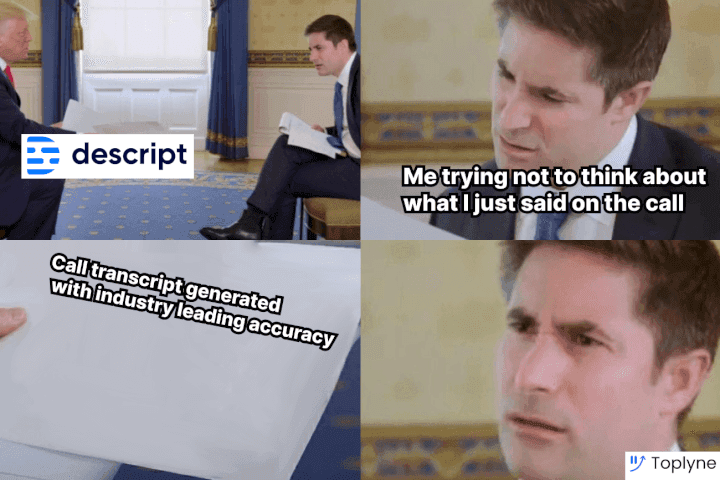


Ask Quentin Tarantino to choose between 35mm film and digital projection and he’d choose a 35mm film any day. It just smells like good ol’ cinema - he’d say. From Reservoir Dogs to Once Upon a Time in Hollywood - all ten of his films were shot on film.
But today, Tarantino is the exception, far from the norm.
In 2000, when Star Wars: Episode 1 became the major motion picture to have an all-digital screening, there were just 30 movie theatres with digital screens in the world. Ten years later, there were more than 36,000. On June 22, 2009, Kodak announced its plan to end production of the Kodachrome film, 74 years after it first made an appearance in 1935. The analogue dynasty was coming to an end.
The physical cutting and splicing together of films with tape and glue, the sprocket gears that fit into the edges of a film that feed 24 images past the lens while the shutter flashes 3 times per second, and the swapping of reels during intermissions - digital filmmaking was about to democratize all of it.
The Casey Neistats and the Mr Beasts of the world today are able to stitch together hours and days of audio and video footage in minutes. A process that used to take months. As Tarantino might tell them “And I will strike down upon thee. With great vengeance and furious an-” no, we’re kidding.
Their latest weapon of content disruption? Descript.
Detour from “Detour” 🛣
🕛 February 2013. Amidst growing public market scrutiny and a stock price that plunged to a quarter of its listing price; Groupon’s infamous CEO, Andrew Mason, in an internal memo to his employees, writes…
"After four and a half intense and wonderful years as CEO of Groupon, I've decided that I'd like to spend more time with my family. Just kidding - I was fired today."

Here was a non-conformist, brutally honest, self-deprecating, anti-CEO; taking both success and failure with a pinch of salt.
At the time of his unceremonious ousting, Mason was worth more than $200M in Groupon stocks. Yet, he has had to scavenge for the idea for his next project by reminiscing his pre-millionaire days.
“It turns out you can't have good ideas after you've achieved financial independence,” Mason quips.
The founding roots of Descript is really an affirmation of Jobs’ iconic quote “You can’t connect the dots looking forward. You can only connect them looking backwards.”
By the end of the year, Mason was building Detour, an Augmented Reality travel experience app. Here, Mason and the team faced a recurring, adjacent problem worth solving for. Sessions for the tour with local guides used in Detour were easy to record but post-production would take hours, if not days to finish.
Editing soundbites for a high-quality end-product was cumbersome and would often require renting studios, and hiring technicians - just a lot of overhead.
To overcome these limitations, the team looked toward the advancements happening at the intersection of Machine Learning and Natural Language Processing. Andrew noticed that the AI-ML speech-to-text was at a real inflexion point and had become accurate enough to find commercial use-cases.
Quickly building a What-You-See-Is-What-You-Get audio editing tool that not just transcribes speech to text but also lets you edit the audio by simply editing the text document— and Voila! you’ve got yourself a ready-to-use soundbite.
Although built for internal ease of use and recording, the tool garnered interest from video producers and podcasters all of whom begged Mason to make the software available to them like, yesterday.
🕓 December 2017. Seeing more merit in their editing tool, the team took a literal detour from Detour and decided to dedicatedly focus on building an AI-led narrative-based media creation software.
To do this at scale, Mason & team quickly bagged $5Mn in seed funding from Andreessen-Horowitz.
🕢 2021 - 2022
Today, Descript offers transcription in over 22 languages and encompasses audio editing via text-in-a-doc to doing the same for video🤯; It even reverses text into speech with its revolutionary feature “Overdub” (brought to life with its acquisition of Lyrebird); and also allows multi-player editing.
Propelled by an explosion in the creator economy and a podcasting boom, Descript eliminates the uphill drudgery standing in between you and the end result, so you can focus on what truly matters: the quality of your content. ⚡️
With over $50Mn in total funding, Descript’s latest round - their Series B was led by Nabeel Hyatt of Spark Capital with Andreessen Horowitz and Redpoint Ventures participating.
An indicator of strong PMF, the latest round also saw participation from a number of individuals, a lot of whom are renowned for their own video podcasting and publishing work; among them Devdatta Akhawe, Alex Blumberg, Jack Conte, Justine Ezarik, Todd Goldberg, Jean-Denis Greze, John Lilly, Tobi Lutke, Bharat Mediratta, Shishir Mehrotra, Casey Neistat, Brian Pokorny, Raghavendra Prabhu, Lenny Rachitsky, Naval Ravikant, Jay Simons, Jake Shapiro, Rahul Vohra, and Ev Williams…….
Phew.
Product-led all the way 📈
A tool that makes audio-visual file editing as easy as editing a word document, Descript is on a mission to democratize content production. The speech-to-text AI-driven media tool upends status quo tools (read: complicated music and audio editing software) that have a steep learning curve, by making audio editing as accessible as using Google Docs - yep, you heard that right.
The takers? Naval, Lenny Rachitsky, Casey Neistat, and about 4,000 others as seen in their free-to-join Discord community.
They all think it’s magic. We agree.
Descript is a poster child for product-led growth - with levers and an attention-to-detail that put the user experience at the centre of the organization’s priorities.
Freemium Trial 🆓
Descript competes with the likes of bigwigs like Adobe and Apple’s Final Cut Pro by doing away with any trade-off between power, ease of use, and cost. With the least amount of friction between cognitive thought and its expression, Descript offers users all features for free for up to 3 hours of transcription.

By giving them a taste of the entire gamut of everything they can achieve with Descript, users unlock a realm of possibilities previously unfathomable to most content creators. Having experienced the tool in all its glory, content creators are incentivized to purchase the software as a no-brainer to the current status quo.
Priced at a decent 12$/editor/month for Creator and a 24$/editor/mo for PRO (Contrast this to $20.99/mo for Adobe PRO and $299.99/mo for Final Cut Pro), Descript positions itself as the only editing software you’ll ever need.
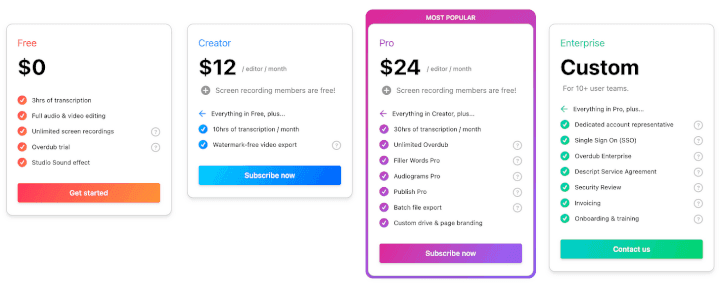
With the flexibility of pay-per-use, users can top up their transcription hours at 2$ per hour.
With the advent of video editing with Descript in 2020, the software aims to aid the backbone of the $22Bn-dollars-in-ad-revenues brought in by monetizable video content. In a massive vote of confidence, Descript’s Custom plan for Enterprises has found takers in legacy media houses The New York Times and The Washington Post, as well as more contemporary names like VICE.
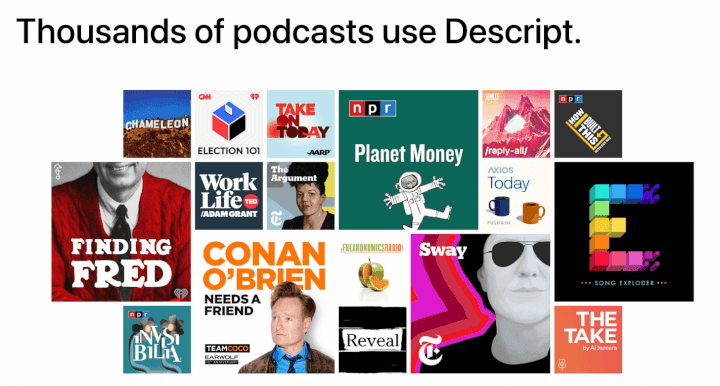
Hubspot and Zapier are also among the many B2B companies that have jumped on the Descript hype train, editing explainer videos, churning social media videos, producing podcasts, webinars interactive sales pitches, and a lot, lot more!
By building trust with audio-first and perfecting their technology, Descript’s foray into video-editing-in-a-doc is a huge step towards its mission of enabling a new era of AI-driven media production.
“There is so much to build, so we wanted to start with some version of the product, and then add features in concentric circles of addressable markets,” - Andrew Mason, CEO, Descript
Everyone’s Invited to the Party 👯♂️
Doing away with the elusive nature of audio-visual editing, Descript is inviting everyone to the editing table. By allowing users to invite as many Basic members as they’d like — no upper limit whatsoever — the magic of the tool is witnessed by a plethora of new users, at zero CAC.
Basic members have access to unlimited screen recordings and transcriptions. Apart from watching editors live in action, users can also add or edit up to 3 clips. Collaborators (aka basic members) can export videos, comment on and correct transcriptions,
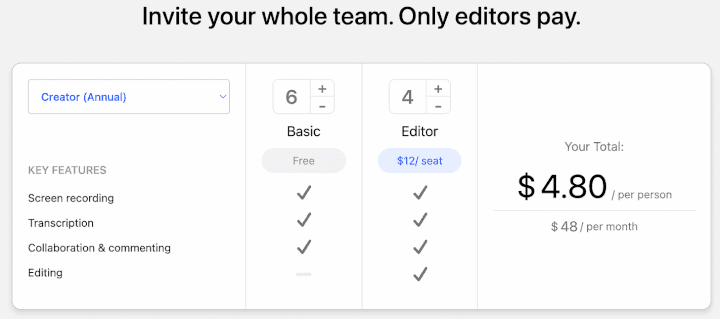
They can even invite other basic members to the Drive, and the flywheel continues. 🎡
Frictionless Onboarding 🚝
Unlike its incumbents, Descript reduces time to value and prevents drop-off with a short, sweet, and frictionless onboarding that places the user at the centre as the real hero, not the product. As Casey Winters puts it, people should get to the core of the product as fast as possible, but not faster. Descript puts this into action by putting the user in the driver’s seat.
💭 Trading “product information/tours” for questions that identify user motivation
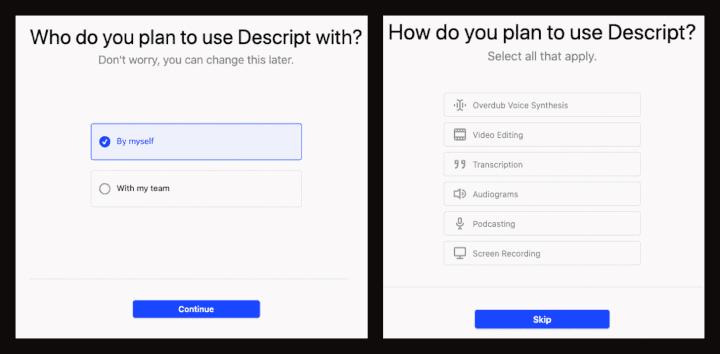
✍🏼 Using crisp, crystal clear (no jargon), and non-intrusive copy
With copy that wins hearts, ”We recommend this brief tutorial” → Descript wants to give you a tour but is also mindful of your time.
Two non-intrusive steps and you’re in. 🏆
Build features PMs think customers want 💪🏻
Descript has an easy-to-access and navigate feature requests dashboard as well as a Roadmap that buckets the features into “In Progress”, “Planned” and “Under Review” — making the user feel like the hero in the product’s journey, right up there in the front row with Andrew & rest of the team.

Build-in-public in action → In 2017, Andrew posted “Multi-language transcription support” as a possible feature, which quickly got 477 upvotes. In 2022, this feature is marked “Complete” and successfully shipped 🚀
Affiliate Program 🤝
Descript catches its users where they hang out the most online.
89% of all traffic from social networks to Descript comes from YouTube. Owing partly to their stellar resource hub i.e. their official YT channel but mostly to their deceptively simple affiliate program.
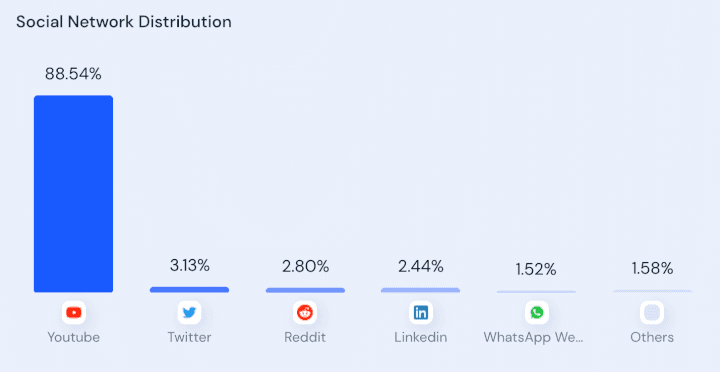
Upon entering basic information like platform, number of followers/subscribers, and how they plan on promoting the product, approved affiliates get a custom link and a 15% one-time recurring 🔂 commission through the first year of each new PRO or Creator subscription 💰
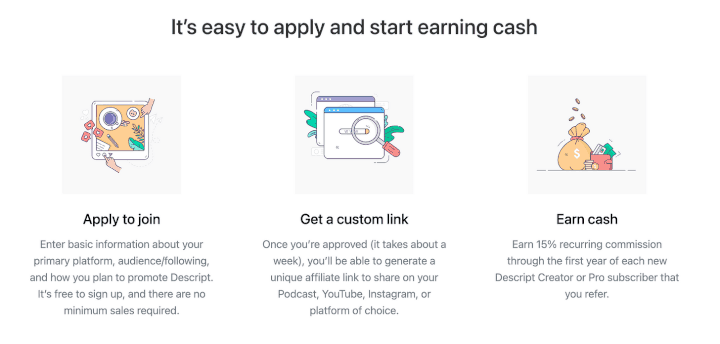
By offering incentives users actually care about, Descript is able to kickoff a flywheel of growth not just for acquiring new users, but also for turning them into staunch ambassadors! (read: affiliates).
The fact that Descript comes highly recommended by “trusted” creators is impactful, cost-efficient, and an easy-to-scale growth lever.

Content to fuel Creator Ecosystem 📑
Descript’s approach to content is directly in service of its addressable market: the Creator Ecosystem. Their ads distil their approach to building Descript: humanize SaaS and make software fun 👇🏼
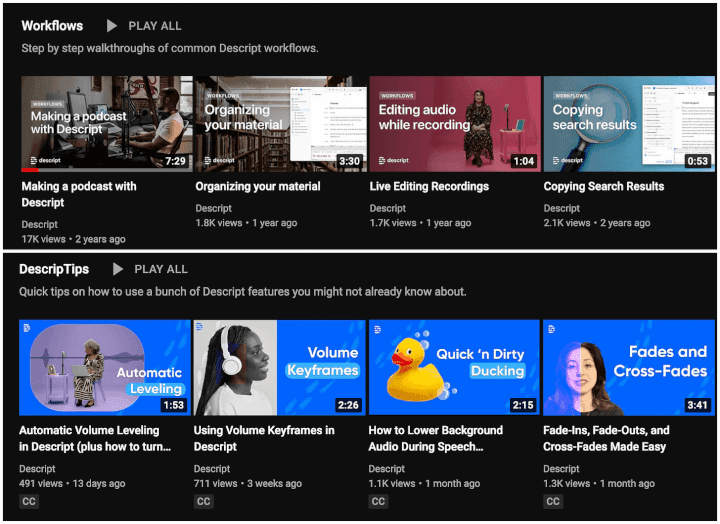
Their SEO strategy, too, is built around ranking for the creator ecosystem as a whole. Ranking #1 for product-specific long-tail keywords like “free audio transcription,” “free video transcription” and “voice imitation” as well as market-defining keywords like “how much money can a podcast make” and “how do I get into voice acting.”
Layering in a Sales Customer-assist motion 🛶
Descript’s turbocharged PLG engine is complemented by a sales-assist motion that kicks into play when and only when necessary. Although users can go down the pure self-serve motion if they should so choose, teams and businesses that can benefit from low-touch human assistance are engaged through customer success advocates - via chat, e-mail, and short calls.

Descript’s entrepreneurial teams operate in a non-commissioned environment that they call a “Customer-assist” model - where these teams are empowered to make decisions that align with end-user interest and the product’s long-term vision.
All touchpoints that are a part of the user journey are introduced as and when the use cases progress from niche to enterprise. The level of intervention ranges from purely self-serve to white-glove service from Customer Success Managers and Strategic Account Managers.
Descript has succeeded in striking a balance that many PLG companies before them have struggled to find: Layering sales into a PLG flywheel.
What’s next 🔮
After announcing its Series B in January 2021, Descript brought in Sandy Diao, previously driving growth and monetization at Facebook and Pinterest, as its Director of Growth. Under her leadership, Descript’s growth team has been rapidly experimenting with full-funnel strategies to further optimize customer activation, retention and monetization. They’re also hiring a Director of Sales to take Enterprise up by several notches.
On the product front, the fresh funds will largely be allocated towards building out tools and features not just for individual creators but for organizations that increasingly own in-house audio and video needs, owing largely to remote work brought about by the pandemic.
To this effect, Descript announced the release of Season 3. Their biggest release, ever.
The bold claim? Video reinvented, changing how you work with visuals forever. Descript’s Discord is abuzz as the release goes live tomorrow, and Andrew will personally answer any questions around new features, use-cases, and the works!
A gift that keeps on giving, Descript is notorious for its frequent upgrades and feature shipping. This year’s lineup (Overdub for more languages, Saved outro and intro templates, ability to rotate and crop clips), continues to live up to the hype. 🎯
Oh, they’re also hiring Applied Research Scientists and Research Engineers from the Deep Learning, Generative models and NLP space to guide their product roadmap and assist the development of cutting-edge AI/ML technology.
Just another day at Descript.
No big deal. 💁🏻♀️
Ask Quentin Tarantino to choose between 35mm film and digital projection and he’d choose a 35mm film any day. It just smells like good ol’ cinema - he’d say. From Reservoir Dogs to Once Upon a Time in Hollywood - all ten of his films were shot on film.
But today, Tarantino is the exception, far from the norm.
In 2000, when Star Wars: Episode 1 became the major motion picture to have an all-digital screening, there were just 30 movie theatres with digital screens in the world. Ten years later, there were more than 36,000. On June 22, 2009, Kodak announced its plan to end production of the Kodachrome film, 74 years after it first made an appearance in 1935. The analogue dynasty was coming to an end.
The physical cutting and splicing together of films with tape and glue, the sprocket gears that fit into the edges of a film that feed 24 images past the lens while the shutter flashes 3 times per second, and the swapping of reels during intermissions - digital filmmaking was about to democratize all of it.
The Casey Neistats and the Mr Beasts of the world today are able to stitch together hours and days of audio and video footage in minutes. A process that used to take months. As Tarantino might tell them “And I will strike down upon thee. With great vengeance and furious an-” no, we’re kidding.
Their latest weapon of content disruption? Descript.
Detour from “Detour” 🛣
🕛 February 2013. Amidst growing public market scrutiny and a stock price that plunged to a quarter of its listing price; Groupon’s infamous CEO, Andrew Mason, in an internal memo to his employees, writes…
"After four and a half intense and wonderful years as CEO of Groupon, I've decided that I'd like to spend more time with my family. Just kidding - I was fired today."

Here was a non-conformist, brutally honest, self-deprecating, anti-CEO; taking both success and failure with a pinch of salt.
At the time of his unceremonious ousting, Mason was worth more than $200M in Groupon stocks. Yet, he has had to scavenge for the idea for his next project by reminiscing his pre-millionaire days.
“It turns out you can't have good ideas after you've achieved financial independence,” Mason quips.
The founding roots of Descript is really an affirmation of Jobs’ iconic quote “You can’t connect the dots looking forward. You can only connect them looking backwards.”
By the end of the year, Mason was building Detour, an Augmented Reality travel experience app. Here, Mason and the team faced a recurring, adjacent problem worth solving for. Sessions for the tour with local guides used in Detour were easy to record but post-production would take hours, if not days to finish.
Editing soundbites for a high-quality end-product was cumbersome and would often require renting studios, and hiring technicians - just a lot of overhead.
To overcome these limitations, the team looked toward the advancements happening at the intersection of Machine Learning and Natural Language Processing. Andrew noticed that the AI-ML speech-to-text was at a real inflexion point and had become accurate enough to find commercial use-cases.
Quickly building a What-You-See-Is-What-You-Get audio editing tool that not just transcribes speech to text but also lets you edit the audio by simply editing the text document— and Voila! you’ve got yourself a ready-to-use soundbite.
Although built for internal ease of use and recording, the tool garnered interest from video producers and podcasters all of whom begged Mason to make the software available to them like, yesterday.
🕓 December 2017. Seeing more merit in their editing tool, the team took a literal detour from Detour and decided to dedicatedly focus on building an AI-led narrative-based media creation software.
To do this at scale, Mason & team quickly bagged $5Mn in seed funding from Andreessen-Horowitz.
🕢 2021 - 2022
Today, Descript offers transcription in over 22 languages and encompasses audio editing via text-in-a-doc to doing the same for video🤯; It even reverses text into speech with its revolutionary feature “Overdub” (brought to life with its acquisition of Lyrebird); and also allows multi-player editing.
Propelled by an explosion in the creator economy and a podcasting boom, Descript eliminates the uphill drudgery standing in between you and the end result, so you can focus on what truly matters: the quality of your content. ⚡️
With over $50Mn in total funding, Descript’s latest round - their Series B was led by Nabeel Hyatt of Spark Capital with Andreessen Horowitz and Redpoint Ventures participating.
An indicator of strong PMF, the latest round also saw participation from a number of individuals, a lot of whom are renowned for their own video podcasting and publishing work; among them Devdatta Akhawe, Alex Blumberg, Jack Conte, Justine Ezarik, Todd Goldberg, Jean-Denis Greze, John Lilly, Tobi Lutke, Bharat Mediratta, Shishir Mehrotra, Casey Neistat, Brian Pokorny, Raghavendra Prabhu, Lenny Rachitsky, Naval Ravikant, Jay Simons, Jake Shapiro, Rahul Vohra, and Ev Williams…….
Phew.
Product-led all the way 📈
A tool that makes audio-visual file editing as easy as editing a word document, Descript is on a mission to democratize content production. The speech-to-text AI-driven media tool upends status quo tools (read: complicated music and audio editing software) that have a steep learning curve, by making audio editing as accessible as using Google Docs - yep, you heard that right.
The takers? Naval, Lenny Rachitsky, Casey Neistat, and about 4,000 others as seen in their free-to-join Discord community.
They all think it’s magic. We agree.
Descript is a poster child for product-led growth - with levers and an attention-to-detail that put the user experience at the centre of the organization’s priorities.
Freemium Trial 🆓
Descript competes with the likes of bigwigs like Adobe and Apple’s Final Cut Pro by doing away with any trade-off between power, ease of use, and cost. With the least amount of friction between cognitive thought and its expression, Descript offers users all features for free for up to 3 hours of transcription.

By giving them a taste of the entire gamut of everything they can achieve with Descript, users unlock a realm of possibilities previously unfathomable to most content creators. Having experienced the tool in all its glory, content creators are incentivized to purchase the software as a no-brainer to the current status quo.
Priced at a decent 12$/editor/month for Creator and a 24$/editor/mo for PRO (Contrast this to $20.99/mo for Adobe PRO and $299.99/mo for Final Cut Pro), Descript positions itself as the only editing software you’ll ever need.

With the flexibility of pay-per-use, users can top up their transcription hours at 2$ per hour.
With the advent of video editing with Descript in 2020, the software aims to aid the backbone of the $22Bn-dollars-in-ad-revenues brought in by monetizable video content. In a massive vote of confidence, Descript’s Custom plan for Enterprises has found takers in legacy media houses The New York Times and The Washington Post, as well as more contemporary names like VICE.

Hubspot and Zapier are also among the many B2B companies that have jumped on the Descript hype train, editing explainer videos, churning social media videos, producing podcasts, webinars interactive sales pitches, and a lot, lot more!
By building trust with audio-first and perfecting their technology, Descript’s foray into video-editing-in-a-doc is a huge step towards its mission of enabling a new era of AI-driven media production.
“There is so much to build, so we wanted to start with some version of the product, and then add features in concentric circles of addressable markets,” - Andrew Mason, CEO, Descript
Everyone’s Invited to the Party 👯♂️
Doing away with the elusive nature of audio-visual editing, Descript is inviting everyone to the editing table. By allowing users to invite as many Basic members as they’d like — no upper limit whatsoever — the magic of the tool is witnessed by a plethora of new users, at zero CAC.
Basic members have access to unlimited screen recordings and transcriptions. Apart from watching editors live in action, users can also add or edit up to 3 clips. Collaborators (aka basic members) can export videos, comment on and correct transcriptions,

They can even invite other basic members to the Drive, and the flywheel continues. 🎡
Frictionless Onboarding 🚝
Unlike its incumbents, Descript reduces time to value and prevents drop-off with a short, sweet, and frictionless onboarding that places the user at the centre as the real hero, not the product. As Casey Winters puts it, people should get to the core of the product as fast as possible, but not faster. Descript puts this into action by putting the user in the driver’s seat.
💭 Trading “product information/tours” for questions that identify user motivation

✍🏼 Using crisp, crystal clear (no jargon), and non-intrusive copy
With copy that wins hearts, ”We recommend this brief tutorial” → Descript wants to give you a tour but is also mindful of your time.
Two non-intrusive steps and you’re in. 🏆
Build features PMs think customers want 💪🏻
Descript has an easy-to-access and navigate feature requests dashboard as well as a Roadmap that buckets the features into “In Progress”, “Planned” and “Under Review” — making the user feel like the hero in the product’s journey, right up there in the front row with Andrew & rest of the team.

Build-in-public in action → In 2017, Andrew posted “Multi-language transcription support” as a possible feature, which quickly got 477 upvotes. In 2022, this feature is marked “Complete” and successfully shipped 🚀
Affiliate Program 🤝
Descript catches its users where they hang out the most online.
89% of all traffic from social networks to Descript comes from YouTube. Owing partly to their stellar resource hub i.e. their official YT channel but mostly to their deceptively simple affiliate program.

Upon entering basic information like platform, number of followers/subscribers, and how they plan on promoting the product, approved affiliates get a custom link and a 15% one-time recurring 🔂 commission through the first year of each new PRO or Creator subscription 💰

By offering incentives users actually care about, Descript is able to kickoff a flywheel of growth not just for acquiring new users, but also for turning them into staunch ambassadors! (read: affiliates).
The fact that Descript comes highly recommended by “trusted” creators is impactful, cost-efficient, and an easy-to-scale growth lever.

Content to fuel Creator Ecosystem 📑
Descript’s approach to content is directly in service of its addressable market: the Creator Ecosystem. Their ads distil their approach to building Descript: humanize SaaS and make software fun 👇🏼

Their SEO strategy, too, is built around ranking for the creator ecosystem as a whole. Ranking #1 for product-specific long-tail keywords like “free audio transcription,” “free video transcription” and “voice imitation” as well as market-defining keywords like “how much money can a podcast make” and “how do I get into voice acting.”
Layering in a Sales Customer-assist motion 🛶
Descript’s turbocharged PLG engine is complemented by a sales-assist motion that kicks into play when and only when necessary. Although users can go down the pure self-serve motion if they should so choose, teams and businesses that can benefit from low-touch human assistance are engaged through customer success advocates - via chat, e-mail, and short calls.

Descript’s entrepreneurial teams operate in a non-commissioned environment that they call a “Customer-assist” model - where these teams are empowered to make decisions that align with end-user interest and the product’s long-term vision.
All touchpoints that are a part of the user journey are introduced as and when the use cases progress from niche to enterprise. The level of intervention ranges from purely self-serve to white-glove service from Customer Success Managers and Strategic Account Managers.
Descript has succeeded in striking a balance that many PLG companies before them have struggled to find: Layering sales into a PLG flywheel.
What’s next 🔮
After announcing its Series B in January 2021, Descript brought in Sandy Diao, previously driving growth and monetization at Facebook and Pinterest, as its Director of Growth. Under her leadership, Descript’s growth team has been rapidly experimenting with full-funnel strategies to further optimize customer activation, retention and monetization. They’re also hiring a Director of Sales to take Enterprise up by several notches.
On the product front, the fresh funds will largely be allocated towards building out tools and features not just for individual creators but for organizations that increasingly own in-house audio and video needs, owing largely to remote work brought about by the pandemic.
To this effect, Descript announced the release of Season 3. Their biggest release, ever.
The bold claim? Video reinvented, changing how you work with visuals forever. Descript’s Discord is abuzz as the release goes live tomorrow, and Andrew will personally answer any questions around new features, use-cases, and the works!
A gift that keeps on giving, Descript is notorious for its frequent upgrades and feature shipping. This year’s lineup (Overdub for more languages, Saved outro and intro templates, ability to rotate and crop clips), continues to live up to the hype. 🎯
Oh, they’re also hiring Applied Research Scientists and Research Engineers from the Deep Learning, Generative models and NLP space to guide their product roadmap and assist the development of cutting-edge AI/ML technology.
Just another day at Descript.
No big deal. 💁🏻♀️
Related Articles




Behavioral Retargeting: A Game-Changer in the Cookieless Era
Unlock the power of behavioral retargeting for the cookieless future! Learn how it personalizes ads & boosts conversions. #behavioralretargeting




All of Toplyne's 40+ Badges in the G2 Spring Reports
Our customers awarded us 40+ badges in G2's Summer Report 2024.




Unlocking the Full Potential of Google PMax Campaigns: Mastering Audience Selection to Double Your ROAS
Copyright © Toplyne Labs PTE Ltd. 2024
Copyright © Toplyne Labs PTE Ltd. 2024
Copyright © Toplyne Labs PTE Ltd. 2024
Copyright © Toplyne Labs PTE Ltd. 2024